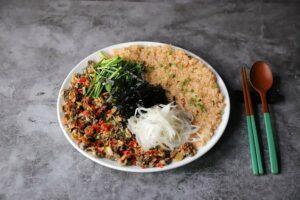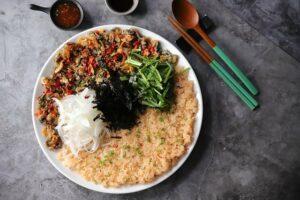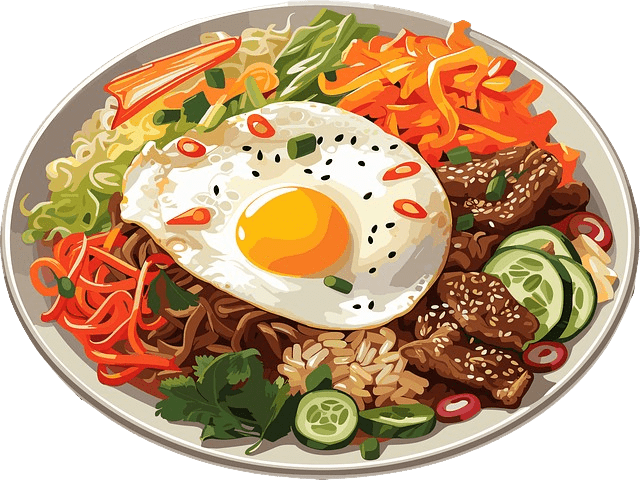How to Make Vegetarian Bibimbap – A Scrumptious Korean Recipe:

Introduction:
In this article, we’re going to explore a delightful and healthy recipe for making Vegetarian Bibimbap. This Korean dish is a beautiful harmony of flavors and textures, making it a perfect choice for those seeking a meatless and satisfying meal. We’ll guide you through each step to ensure you create a delectable Vegetarian Bibimbap in your own kitchen.
What is Vegetarian Bibimbap?
Vegetarian Bibimbap is a vegetarian twist on the classic Korean dish, Bibimbap. It’s a colorful and nutritious one-bowl meal that typically consists of rice, an array of fresh and cooked vegetables, and a flavorful sauce. The name “Bibimbap” itself translates to “mixed rice” in Korean, signifying the core concept of this dish.

Prep 20 min
Cook 40 min
Serves 4
Ingredients:
To create a scrumptious Vegetarian Bibimbap, you’ll need the following ingredients:

For the Rice:
1 cup of short-grain white rice
2 cups of water
For the Vegetables:

1 cup of spinach
1 cup of bean sprouts
1 cup of shredded carrots
1 cup of sliced mushrooms
1 cup of zucchini, julienned
1 cup of cucumber, thinly sliced
1 cup of red bell pepper, julienned
For the Sauce:

2 tablespoons of soy sauce
1 tablespoon of sesame oil
1 tablespoon of brown sugar
1 clove of garlic, minced
Cooking Instructions:

1. Preparing the Rice
Rinse the rice thoroughly until the water runs clear.
Cook the rice following the package instructions. Once cooked, let it cool.
2. Preparing the Vegetables

Blanch the spinach and bean sprouts in boiling water for a minute, then rinse with cold water and drain.
Sauté mushrooms and zucchini in a bit of sesame oil until they become tender.
Sauté shredded carrots in a separate pan until they soften.
3. Making the Sauce
In a small bowl, mix soy sauce, sesame oil, brown sugar, and minced garlic.
4. Assembling the Bibimbap

Place the cooked rice in a bowl.
Arrange each type of vegetable neatly on top of the rice.
Conclusion
Vegetarian Bibimbap is a delightful and healthy dish that’s easy to prepare at home. With its colorful presentation and vibrant flavors, it’s perfect for impressing guests or enjoying a satisfying meal. Get creative with the vegetables you use, and don’t forget to pour that delectable sauce over the top.
Take to the table and encourage your guests to mix everything together gently before eating.
FAQs- Your Culinary Queries Answered:
1. Can I use brown rice instead of white rice for Vegetarian Bibimbap?
Yes, you can substitute brown rice for white rice. It will add a nuttier flavor and more fiber to your dish.
2. Is Bibimbap traditionally vegetarian?
No, traditional Bibimbap usually includes meat, but the vegetarian version replaces the meat with an assortment of vegetables.
3. Can I make the sauce spicier?
Certainly! If you enjoy spicy flavors, you can add a touch of gochujang (Korean red pepper paste) to the sauce for some heat.
4. What other vegetables can I use in Vegetarian Bibimbap?
You can customize your Vegetarian Bibimbap with vegetables like radishes, kale, or even kimchi to add more complexity to the dish.
5. Is Vegetarian Bibimbap suitable for vegans?
Absolutely, Vegetarian Bibimbap can be easily adapted to a vegan diet by ensuring the sauce doesn’t contain any animal-derived ingredients, like fish sauce or honey.
Some extra but important information about Vegetarian Bibimbap – A Scrumptious Korean Recipe:
Cultural significance:
Bibimbap is not only a delicious dish but also has cultural significance in Korea. Traditionally, it was served on the Lunar New Year to ensure the beginning of the new year. Each ingredient in the dish has symbolism, making it a truly unique culinary experience. For example, a mix of colorful vegetables indicates hope for a vibrant future.
Versatility in ingredients:
One of the most interesting aspects of bibimbap is its flexibility when it comes to ingredients. While we’ve outlined a classic vegetarian bibimbap recipe, you can put your own spin on it. Feel free to experiment with different vegetables such as sautéed shiitake mushrooms, julienned radishes, or even sweet potato strips. The key is to maintain a balance of textures and flavors.
A perfectly balanced bowl:
The magic of bibimbap is in the balance of flavors, texture and temperature. You have the softness of blanched spinach, the crispness of fresh cucumber, and the umami of sautéed mushrooms. Top it all off with a savory and slightly sweet sauce, and you’ve got a culinary masterpiece.
Bibimbap Beyond Vegetarian:
While we’re looking at vegetarian versions, it’s worth noting that Bibimbap can also include proteins like beef, chicken, or tofu for those who want a different source of protein. The options are practically endless, making it suitable for a variety of dietary preferences.
Health benefits:
Vegetarian Bibimbap is not only a treat for your taste buds but also a nutritious meal. Loaded with fresh vegetables and rice, it provides a good dose of vitamins, minerals and dietary fiber. A sauce made with sesame oil adds a delicious nutty flavor and healthy fats. This dish is the best choice for those who want to maintain a balanced diet.
Cultural fusion:
Korean food is making its way around the world, and Bibimbap is no exception. You can find it on the menu of international restaurants and adapt it to local tastes. This fusion shows the universal appeal of this delicious dish.
Presentation matters:
In Korean culture, the presentation of a dish is as important as its taste. The colorful arrangement of vegetables on top of the rice is not just for show. It adds to the overall dining experience and is a reflection of the care and attention put into the preparation of the food.
So, the next time you’re in the mood for a satisfying, healthy, and culturally significant meal, consider whipping up some vegetarian bibimbap. With its adaptable nature and rich flavors, this is a delicious dish perfect for both beginners and experienced home cooks.

Enjoy your culinary adventure!



